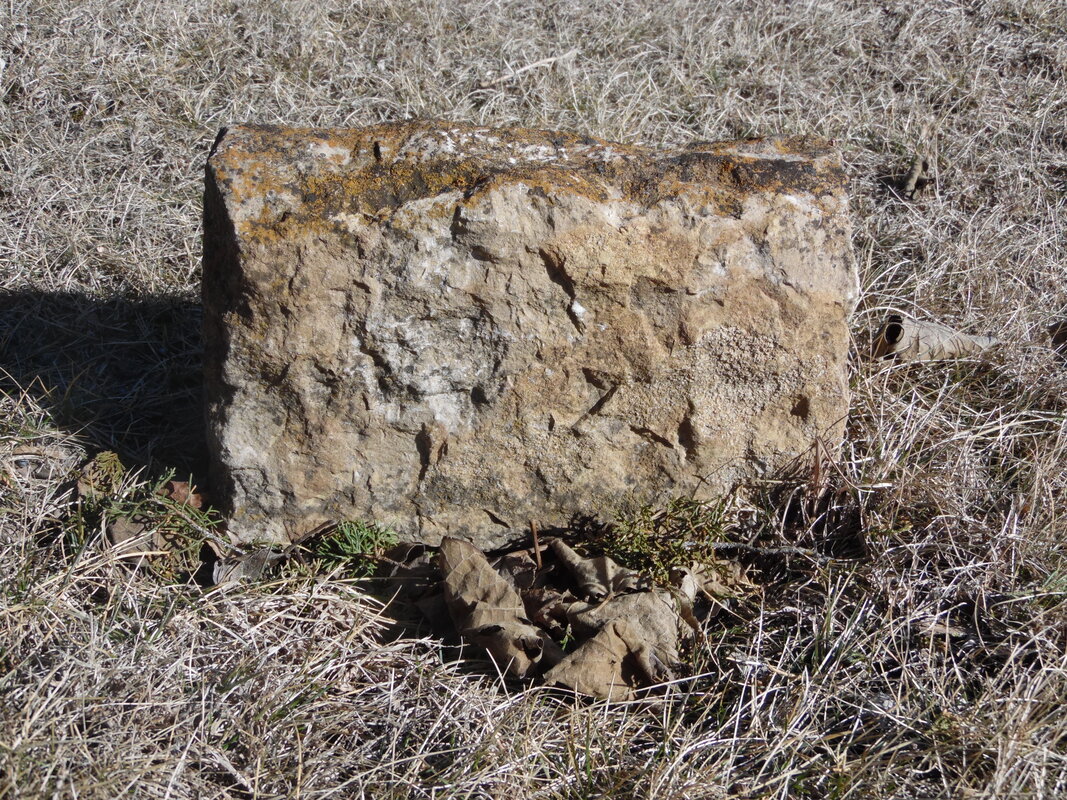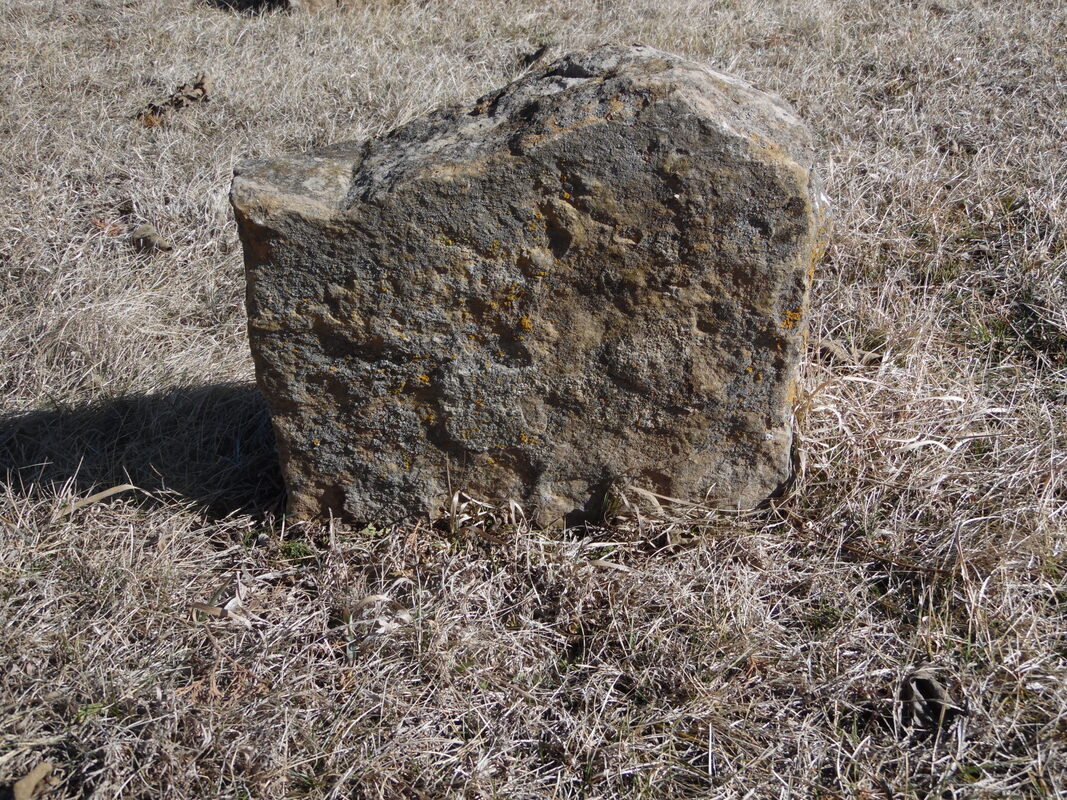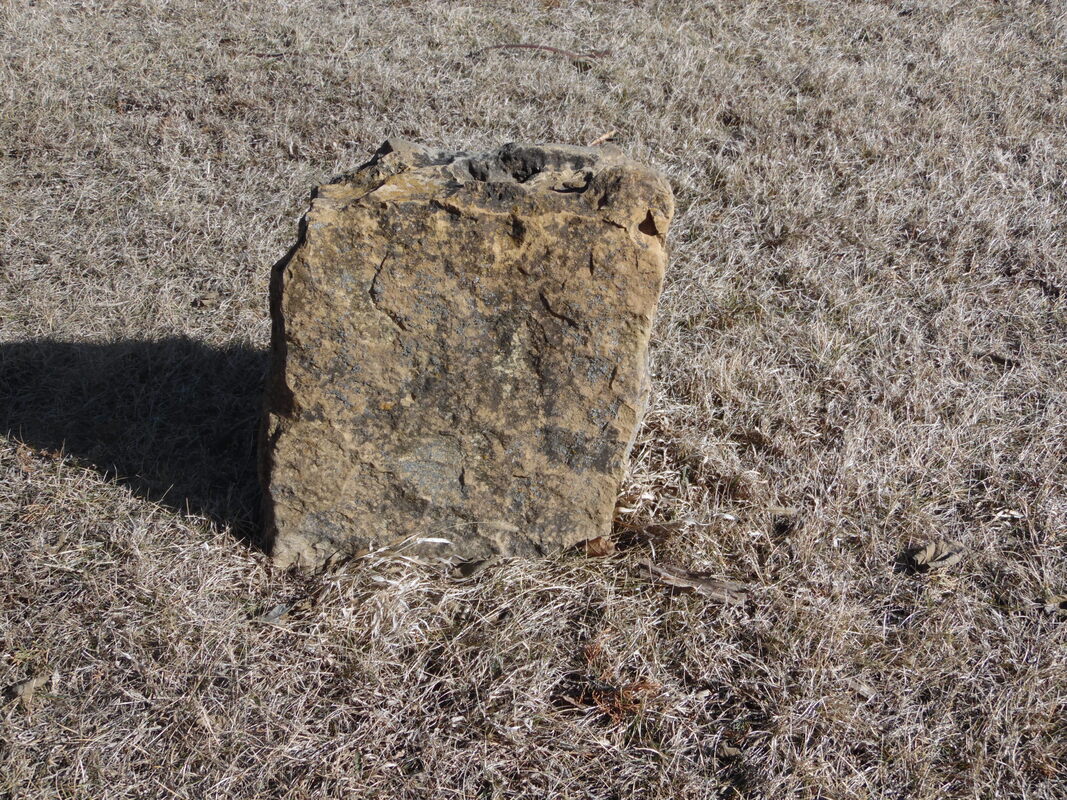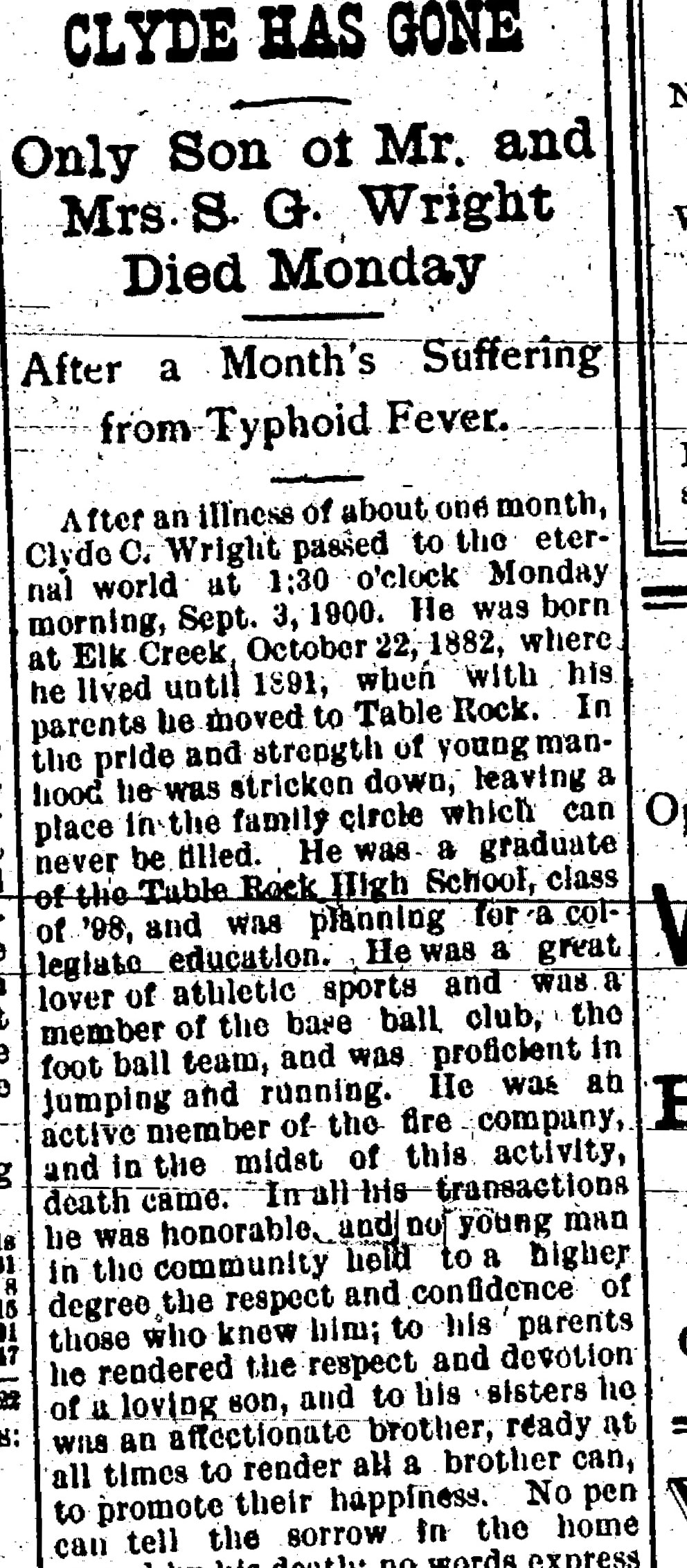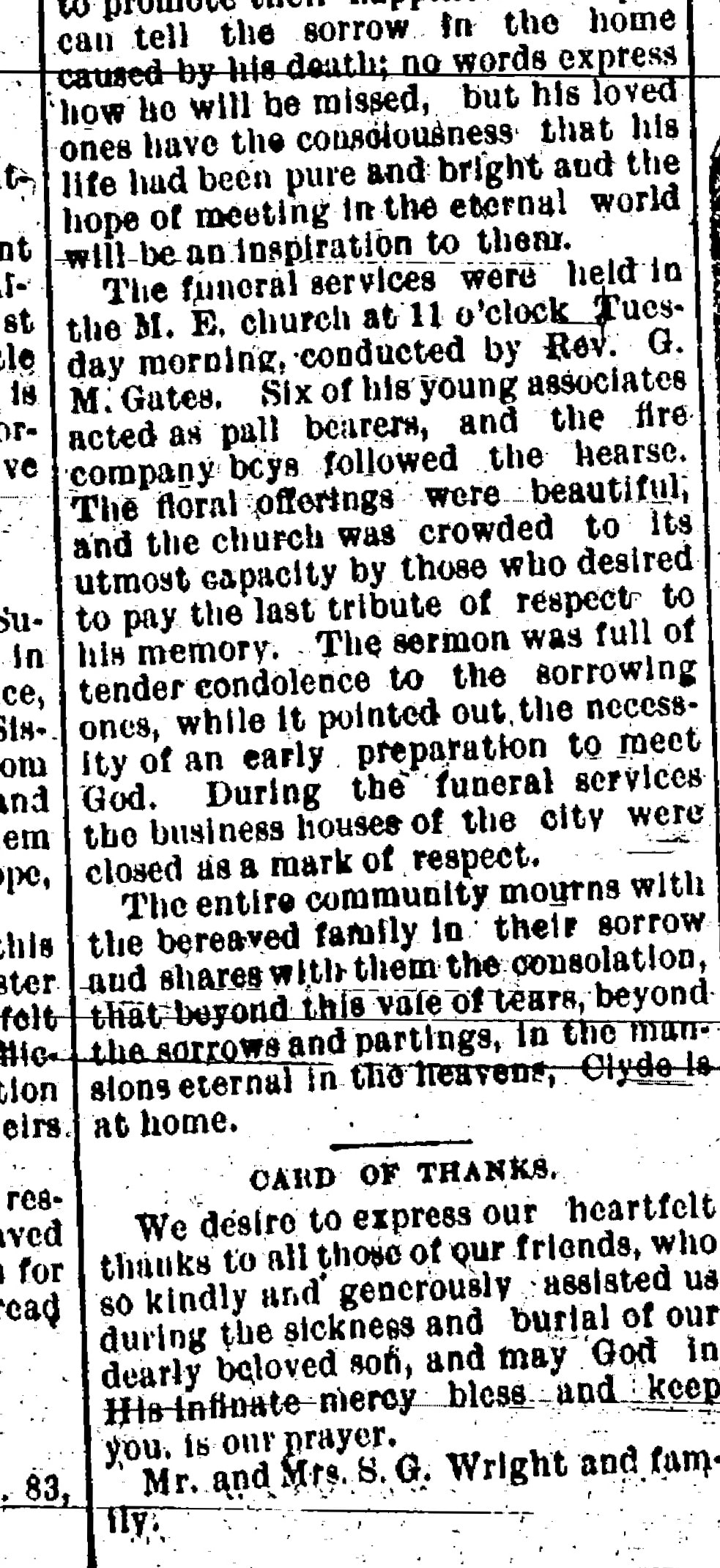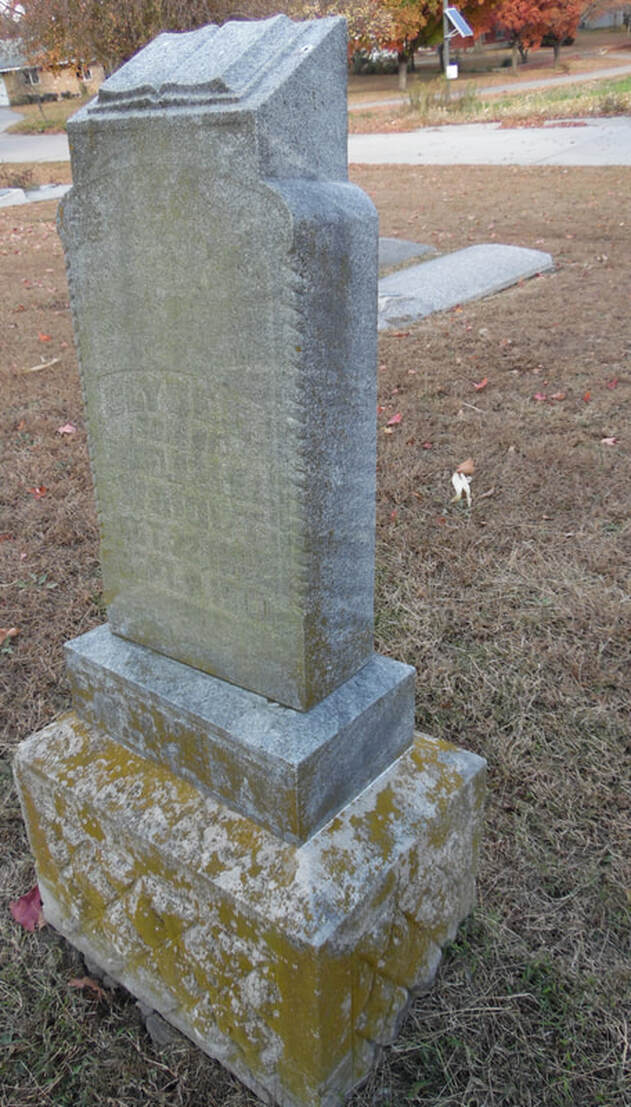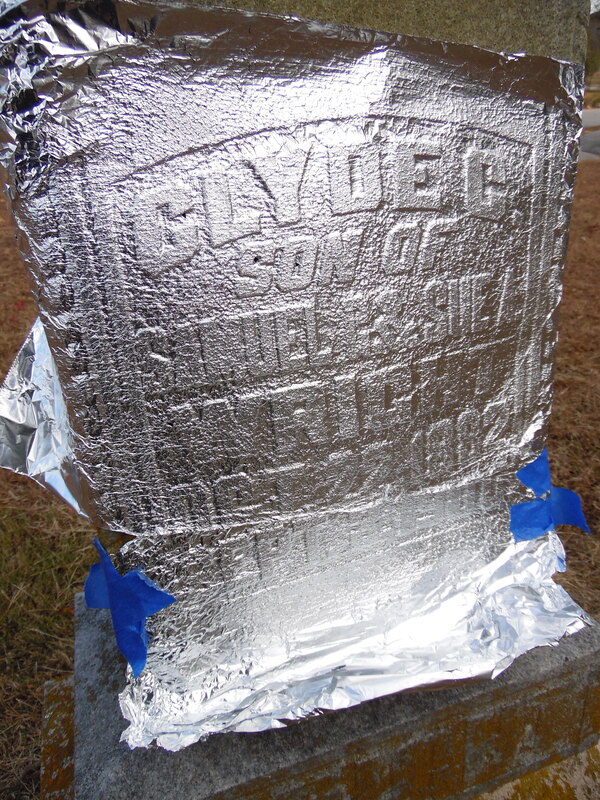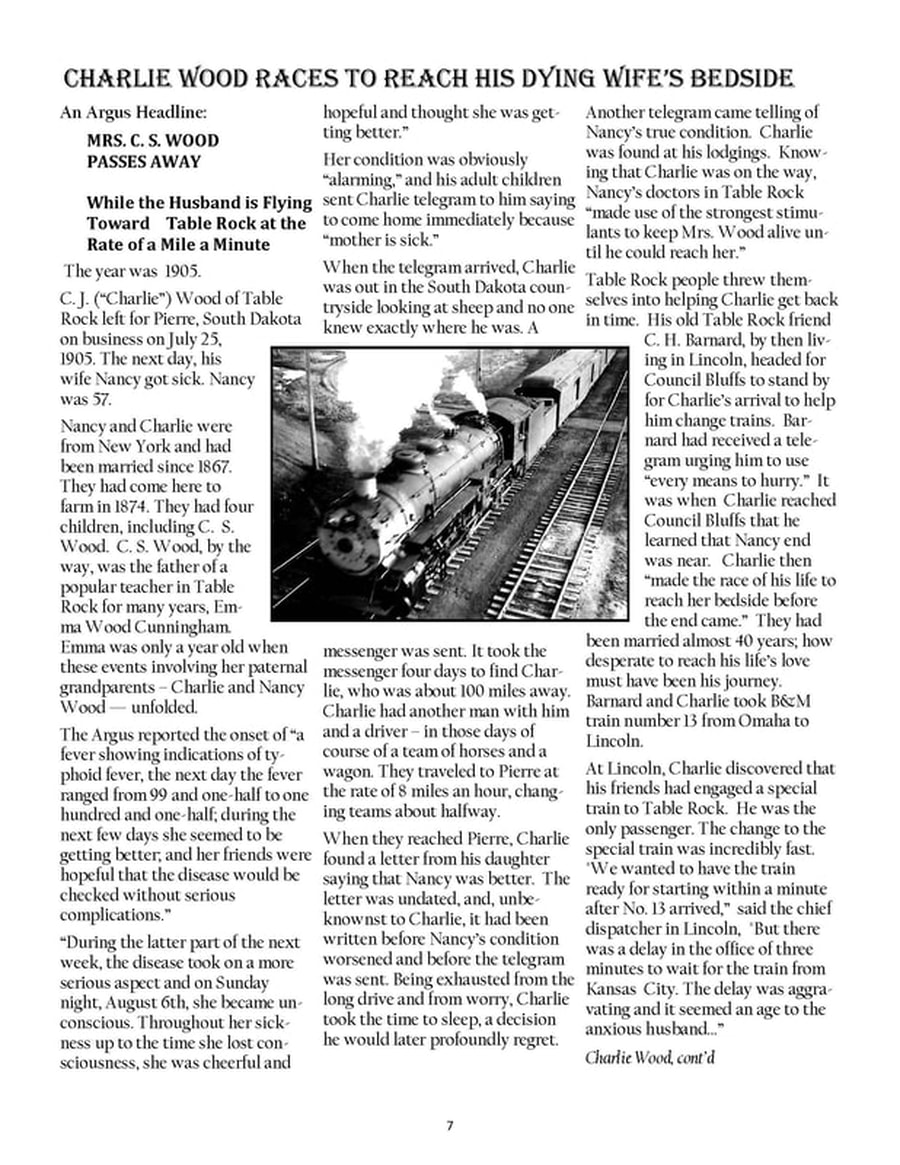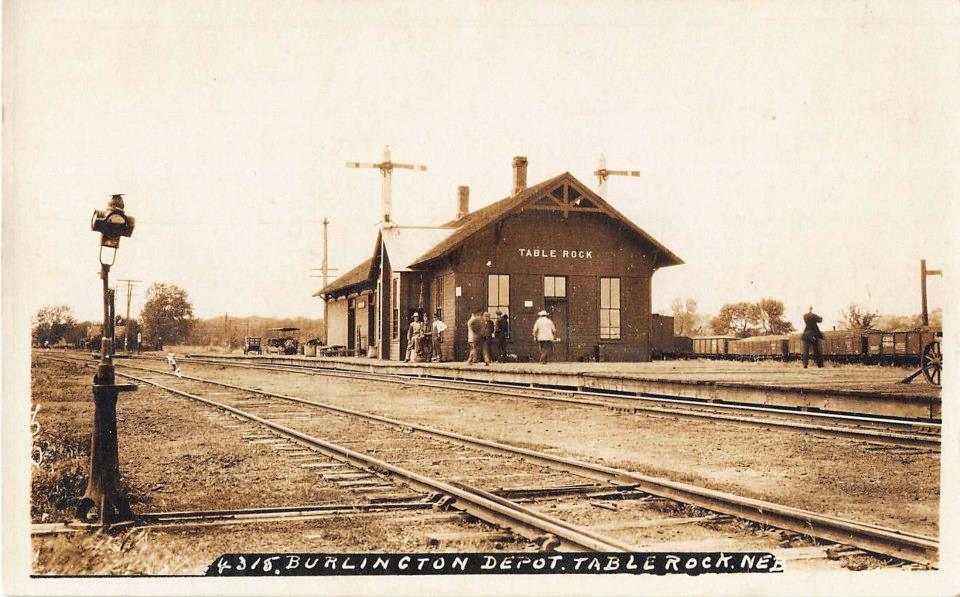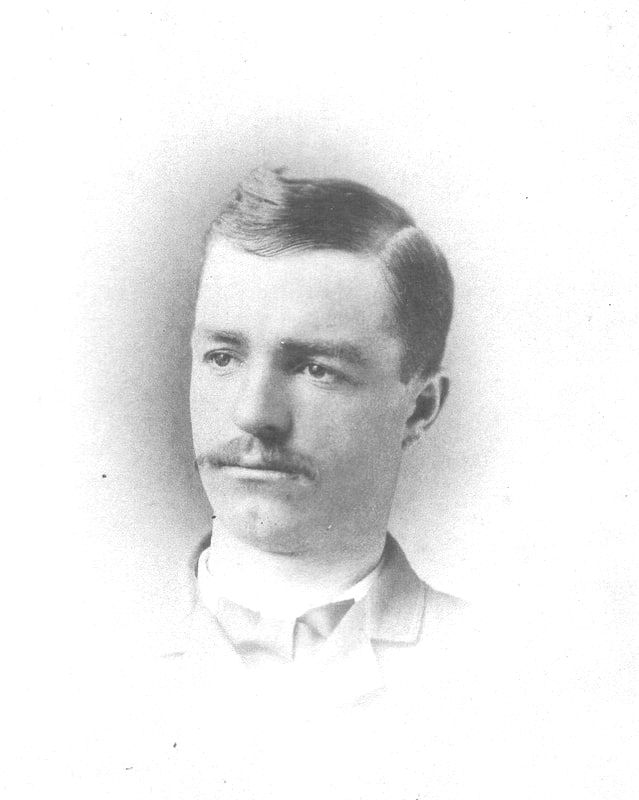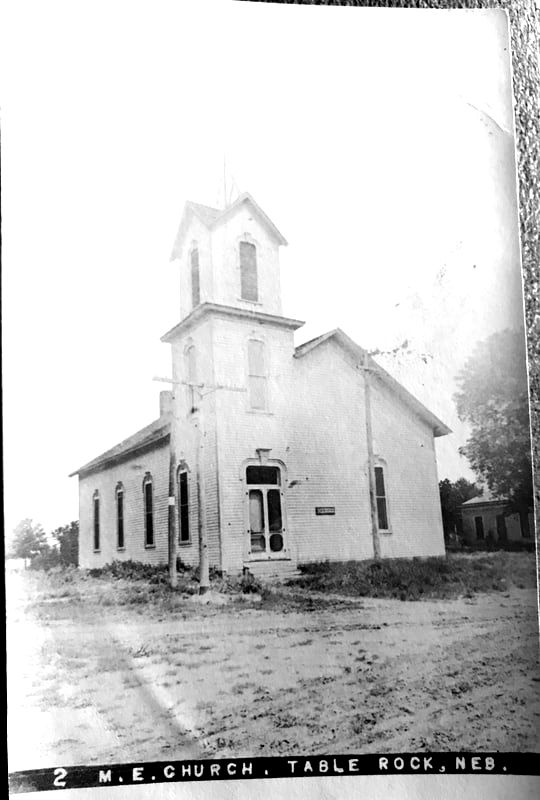DISEASE, ILLNESS, SICKNESS
diptheria, malaria, typhoid Fever, cholera
DIPTHERIA
LYDIA JONES (1870-1877), AGE 7
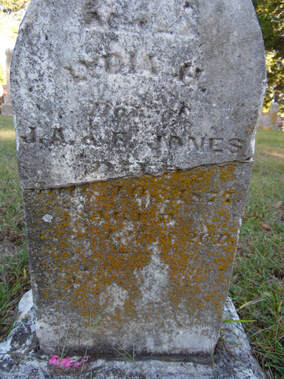
Lydia was the daughter of John and Ellen Jones, who were both born in Wales. They settled first in Carbondale, Pennsylvania, Ellen first as a child and then John as a young man. John came to Table Rock in 1858 to make a home for her then brought her here in 1860. They were married by C. W. Giddings, the Methodist minister who led the pioneers of the Nebraska Settlement Company here from 1856-1858.
Lydia is buried in the Table Rock Cemetery.
Lydia is buried in the Table Rock Cemetery.
typhoid fever
what it is
Typhoid fever was long a scourge of the early settlers and into the 1900s. A description of typhoid fever from the Table Rock Historical Society Newsletter, 2017, Issue #3, accompanying a story about the 1905 death of Nancy Wood, descrbed in the chronology below.
hanna jane gere, 1857
unidentified fever
julia gere, 1859
dies at age 18
poignant family diaries
Juliana was one of the children of Horation N. & Juliana Gere, educated pioneers from Pennsylvania. They came here in 1857 with their young children Hannah Jane, Julia, and George. Their oldest son, Chester H. Gere, stayed behind to attend college. C. H. Gere was unable to return until after the Civil War. By that time, his father and sisters were dead and his brother George grown. He stayed in Table Rock briefly with his mother, then moved to Pawnee City, and then to Lincoln. His career was auspicious. After politics, he quickly founded the influential Nebraska State Journal. A library in Lincoln is named after him.
Juliana wrote of the deaths of her two daughters. She wrote that her dear Hanna Jane, who died in 1857, was the third person to be buried in the new burial ground (the Table Rock Cemetery). Julia, too, was buried there. Neither the grave of Hanna or of Julia is marked today. There are several limestone plinths in the northwest quarter of the cemetery that bear many tool marks but no inscriptions. It may be that one of these marks their resting place, or nothing at all.
Juliana's writings were located, transcribed, and digested by Doralyn Steiner Cheney for her fascinating little book, Stories of Settlers Along the Nemaha (Table Rock Historical Society, 2018). But first, Doralyn started with the words of Julia, herself, as the family first decided to move to the wilds of Nebraska. Doralyn places Julia's writings in context:
Juliana wrote of the deaths of her two daughters. She wrote that her dear Hanna Jane, who died in 1857, was the third person to be buried in the new burial ground (the Table Rock Cemetery). Julia, too, was buried there. Neither the grave of Hanna or of Julia is marked today. There are several limestone plinths in the northwest quarter of the cemetery that bear many tool marks but no inscriptions. It may be that one of these marks their resting place, or nothing at all.
Juliana's writings were located, transcribed, and digested by Doralyn Steiner Cheney for her fascinating little book, Stories of Settlers Along the Nemaha (Table Rock Historical Society, 2018). But first, Doralyn started with the words of Julia, herself, as the family first decided to move to the wilds of Nebraska. Doralyn places Julia's writings in context:
young julia's travel to nebraska with her family
Julia Marie Gere returned to her parents’ home near the town of Greene, New York, for the last time after completing the winter term at the Academy at Oxford, New York. On Saturday, March 14, 1857, she took a few minutes to make the following entry in her diary: “In one week probably we shall be on [our way] to Nebraska, how strange the thought and yet I suppose it is true. I do not care much either way.” [1] The sixteen-year-old girl would be accompanying her parents and younger siblings to Nebraska Territory while her older brother, Charles Henry, remained in the East to continue his education. |
Doralyn writes: "Julia Marie Gere wrote her entries in pencil in a small 1857 diary. (Some entries are hard to read.) Other members of the family also wrote in the diary, usually in ink. I first learned of the Gere diaries from the James and Augusta Griffing website, now expired. Some quotes are from my 2008 six-page printout from that website. I transcribed April entries (page 19 & 20) from the original 1857 diary at the Nebraska State Historical Society’s archives." |
After describing how Giddings came about making a decision to bring settlers to Table Rock, Doralyn returns to Julia:
To a Log Hut in the Wilderness |
Wednesday, April 1 Stayed last night at Mr. Fisher (?) and had plenty of company as thirteen (?) men stayed there also. We crossed Wolf river this morning and the ford was very hard as they have no bridges here. It is very difficult crossing even small streams for the banks are very steep and muddy. We have been in company with the Pennsylvanians today and it makes traveling a great deal pleasanter for they are clever agreeable people. There are about 20 of us in all. |
The Gere family arrived at the Table Rock town site on Tuesday, April 7, 1857. On that day, Julia wrote:
Came to the great City of Table Rock this morning and found that it holds but one house and the body of another and we have moved into this the great City house where we intend to live for the present with the family already there. We are all sadly disappointed and if wishes would take us back to the East we should soon be there. I do not know who is most to blame but we certainly been deceived. |
The town site purchased by the Nebraska Settlement Company was located along a creek known as Taylor’s Branch. In the center of the site was higher land situated on a hill that rose between Taylor’s Branch to the south and Clear Creek to the north.
The Gere family would become one of the earliest families representing the Nebraska Settlement Company to live at Table Rock (Ostwald). For most of the next year they stayed in a small cabin built by the previous owner, John Fleming—the only dwelling in the town site when they came. Probably it was located on lower land near Taylor’s Branch on the eastern end of the town site.[1] The Fleming family, their two boarders and hired man continued to live there until late April while another dwelling was being built for them. They allowed the Geres to “come in with them at once.”
Julia’s disappointment seemed to subside by the next day.
On different occasions Juliana Gere wrote that they were ½ mile from Mrs. Anderson (see page 24), probably in Section 33, and ½ mile from the Giddings’ house (see page 23) located on the site of the present Methodist Church.
The Gere family would become one of the earliest families representing the Nebraska Settlement Company to live at Table Rock (Ostwald). For most of the next year they stayed in a small cabin built by the previous owner, John Fleming—the only dwelling in the town site when they came. Probably it was located on lower land near Taylor’s Branch on the eastern end of the town site.[1] The Fleming family, their two boarders and hired man continued to live there until late April while another dwelling was being built for them. They allowed the Geres to “come in with them at once.”
Julia’s disappointment seemed to subside by the next day.
On different occasions Juliana Gere wrote that they were ½ mile from Mrs. Anderson (see page 24), probably in Section 33, and ½ mile from the Giddings’ house (see page 23) located on the site of the present Methodist Church.
Wednesday, April 8 We are living with a very kind family the mistress of which is but 19 years old and she has one child. [There are two] boarders, one of whom is Mr. C (?) who has left a wife and two children in England and Mr. Smith who is from England. They are both well educated and intelligent. They say Mr. Smith expects a young lady from England this summer whom he will make his wife. |
One year after their arrival, Julia’s mother, Juliana Gere, wrote a longer account about their first year at “Table Rock City”[1] from a little notebook she had kept during 1857.
Our new home consisted of a hewed log house consisting of one room without any loft. . . . A cat could easily go through in many places. The lower floor was made of narrow boards with cracks between each one. . . . The house set up on blocks and not underpinned or banked up. . . . The weather continued cold nearly all the month as cold as it seemed to us as any time during the past winter. Water would freeze sitting in the room in the daytime in a very short time. To add to our discomfort we did not get our freight in two months. We had but one feather bed ̶ two small comforts, one bed quilt, two flannel and two cotton sheets for us six and a boarder besides occasional guest. |
three hand-hewn plinths without inscriptions, not far from a larger one inscribed with the date 1858. who is buried there? perhaps two are for sisters hanna jane & julia gere?
the story of hanna jane's death in 1857, fever unknown
What was it? The family arrived in May 1857. Hanna Jane did not thrive, became very fatigued. By late June, a time when no fresh water was available, she developed an unrelenting thirst, and in July fevers set in.
Cheney transcribes Juliana Gere's diary, beginning with this background: “Our poor Hannah Jane enjoyed but poor health from our first coming here though at times she seemed pretty well,” wrote Juliana Gere. “She with the rest of us suffered most from the cold and crowded beds also from unsuitable foods we having no milk and butter but a short time which we brought with us. Her appetite was poor and she appeared to be laboring under a bad cold.” The following spring Juliana Gere wrote a number of pages about her young daughter’s illness.
In the early part of June she went with Pa and I to our claim and helped sow some garden seeds and she went about a mile to drop corn for her Pa half a day but she came home very tired and went no more. |
Hannah Jane Gere died on July 18, 1857. On the following day, the Sabbath, she was buried.
Mr. Griffin[g] preached an excellent discourse from these words “The Lord giveth and the Lord taketh away blessed be the name of the Lord.” Our room was well filled with sympathizing neighbors and all our acquaintances. . . . Nearly every person present followed her dear form to its final resting place which is about ½ mile distant and is as lovely a spot as I could have selected. Hers was the third grave in the new burial ground on the Town site. |
the story of julia's death in 1859
diptheria
From Stories of Early Settlers Along the Nemaha.
By the end of 1859 there were some who later wrote that a new day had dawned. Unfortunately, one who had come to “the City of Table Rock” two years earlier hoping that she would be happy in a “log hut in the wilderness” did not live to see that new day. In the back of his 1858 diary on a page marked “Memoranda” Horatio N. Gere wrote the following words: “Wed. April 13, 1859 Tonight no meeting. Julia instead of meeting with the rest as formerly was finishing up her brief life. She expired about 8 o’clock Thursday a.m. Dear Julia’s death has made a great impression upon her friends. May it be lasting.”
By the end of 1859 there were some who later wrote that a new day had dawned. Unfortunately, one who had come to “the City of Table Rock” two years earlier hoping that she would be happy in a “log hut in the wilderness” did not live to see that new day. In the back of his 1858 diary on a page marked “Memoranda” Horatio N. Gere wrote the following words: “Wed. April 13, 1859 Tonight no meeting. Julia instead of meeting with the rest as formerly was finishing up her brief life. She expired about 8 o’clock Thursday a.m. Dear Julia’s death has made a great impression upon her friends. May it be lasting.”
Juliana Gere wrote about her daughter’s battle with diphtheria on unused pages in Julia’s small 1857 diary. After Julia’s April 9th entry written in pencil (see page 20), her mother penned the following:
April 10 Two years from the time the above was inserted in this journal – the owner and writer of what is contained herein was taken sick from the effects of a violent cold and had to take her bed. First she had a fever which from its symptoms appeared to be of the bilious type accompanied with a very sore throat. She ate nothing this day but a little custard. The fever abated at night and she rested tolerably well. |
Doralyn writes, "I have transcribed these entries from the original diary at the Nebraska State Historical Society’s archives, and photocopies thereof, with the help of my sister, Sylvia Moore."
According to the CDC, dipthreia is a bacterial infection. "The bacteria that cause diphtheria can get into and attach to the lining of the respiratory system, which includes parts of the body that help you breathe. When this happens, the bacteria can produce a poison (toxin) that can cause:
The poison may also get into the blood stream and cause damage to the heart, nerves, and kidneys." |
In addition to Horatio and Juliana Gere, Fanny and Lydia Giddings spent that last night near Julia’s bedside. It may have been sometime later that Juliana Gere added more about Julia’s last night using both sides of five additional pages in the small diary. (Some pages from August were removed and pinned in among the April pages to provide enough space.) Starting a new paragraph she wrote:
I felt pretty sure some time before morning that her end was nigh. I called her Father. . . . We broke our fears to her as gently as we could. First I asked her if she should never see [Charles] Henry again what should I tell him from her. Said she, “Tell him I love him” and immediately added, “tell Br. Gee and Sister Gee [Rev. and Mrs. Giddings] that I loved them till I died.” This she said with much emphasis. |
After bequeathing some of her possessions to those around to her, Julia asked:
“If I die what shall I be buried in?” After mentioning several garments without fixing upon any, Fanny said, “You shall have my white dress” one Julia had embroidered for her. “Oh no I will not take that – but I will take that white cassock you had of Mrs. Chambers and you shall take my lawn shirt she gave me in return. Told us to choose between two linen shirts she mentioned to wear with the cassock. Then she gave us to understand that we knew her feelings about strangers washing or dressing her person for its last repose – “None but one of you must do it” addressing Fanny & me “especially the washing.” After her mind was satisfied in the adjustment of these things – she again expressed her joy at the prospect of being so near her better home – of her reunion with her friends who had gone before. Mentioned Sister (?) , a beloved Sunday school Teacher and eminent Christian. “But Jesus, Jesus is better than all the rest.” This blessed name was often upon her lips. . . . She could now speak with difficulty and not much above a whisper. |
clyde wright, 1900
the only son of local druggist sam wright & wife sue
dies at age 17
february 4, 1900 table rock argus
Two children of Samuel & Susan Wright came down with typhoid fever in August 1900 -- identified initially as "malarial" fever.
mary herrick, 1901
typhoid fever
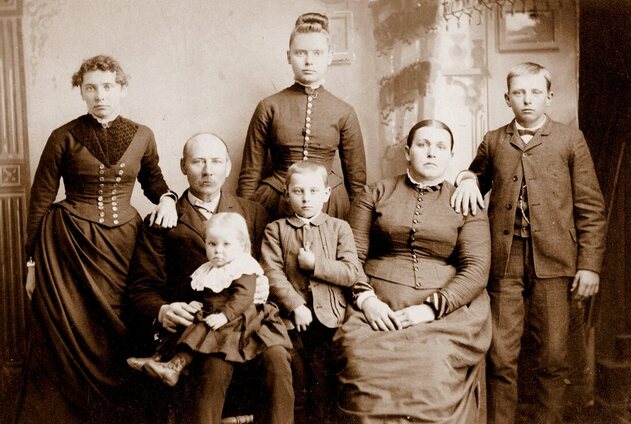 Mary with husband William D'Arcy Herrick and five of their children -- Their youngest, Bessie, had apparently not yet been born, dating this picture prior to 1886. That must be Walter on his father's lap--yes, that's a boy, they often dressed them that way when little, back then. Photo 3963, shared by Brad Bowen
Mary with husband William D'Arcy Herrick and five of their children -- Their youngest, Bessie, had apparently not yet been born, dating this picture prior to 1886. That must be Walter on his father's lap--yes, that's a boy, they often dressed them that way when little, back then. Photo 3963, shared by Brad Bowen
In 1864, Mary West and William D'Arcy Herrick were married (1844-1901, 1835-1902). She died in 1901 and he the year after.
Their children were: Minnie Herrick Asher (1867-1939), William M. Herrick (1869-1962), Lola Herrick Phillips (1872-1970), Infant Herrick (1874-1874), Walter Herrick (1875-1881), John Herrick (1879-1936), and Bessie Herrick Covault (1886-1948).
ary's obituary in the September 5, 1901 Argus describes her death: "Mrs. W. Herrick, wife of one of Pawnee county's prominent farmers residing in Clear Creek, died early yesterday morning from complications arising from typhoid fever. She had been in poor health for a year, and when attacked by typhoid was in poor condition to withstand the ravages of the disease. During the illness of her son, John, with the same malady, she was untiring in her efforts to care for him, then she was taken down and suffered for four or five weeks. The funeral will be held at the house at 2:00 this afternoon, interment in the Table Rock cemetery. She was beloved by a large circle of acquaintances and the sympathy of all goes out to the afflicted husband and children. Bessie, the youngest daughter has much improved, but there is little change in the condition of Mrs. Asher, another daughter, who is down with the same disease."
Their children were: Minnie Herrick Asher (1867-1939), William M. Herrick (1869-1962), Lola Herrick Phillips (1872-1970), Infant Herrick (1874-1874), Walter Herrick (1875-1881), John Herrick (1879-1936), and Bessie Herrick Covault (1886-1948).
ary's obituary in the September 5, 1901 Argus describes her death: "Mrs. W. Herrick, wife of one of Pawnee county's prominent farmers residing in Clear Creek, died early yesterday morning from complications arising from typhoid fever. She had been in poor health for a year, and when attacked by typhoid was in poor condition to withstand the ravages of the disease. During the illness of her son, John, with the same malady, she was untiring in her efforts to care for him, then she was taken down and suffered for four or five weeks. The funeral will be held at the house at 2:00 this afternoon, interment in the Table Rock cemetery. She was beloved by a large circle of acquaintances and the sympathy of all goes out to the afflicted husband and children. Bessie, the youngest daughter has much improved, but there is little change in the condition of Mrs. Asher, another daughter, who is down with the same disease."
nancy wood, 1905
TRAVELING AT THE
AMAZING SPEED OF A MILE A MINUTE
A DESPERATE ATTEMPT TO REACH his wife as she lay dying of typhoid fever
The 1905 Argus article is headlined:: "Mrs. C. S. Wood Passes Away While the Husband is Flying Toward Table Rock at the Rate of a Mile a Minute." Here's the story by Sharla Sitzman as derived from the article, her obituary and his, reprinted from the Table Rock Historical Society Newsletter, 2017, Issue #3.

